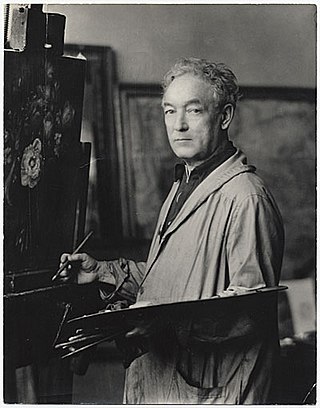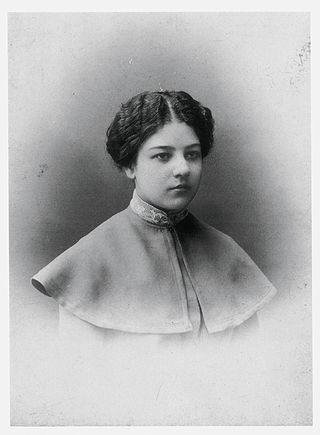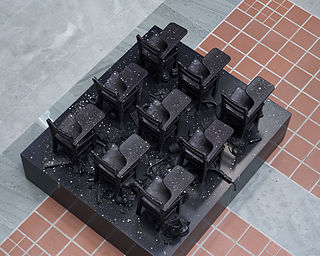Related Research Articles

Robert Wilson is an American experimental theater stage director and playwright who has been described by The New York Times as "[America]'s – or even the world's – foremost vanguard 'theater artist.'" He has also worked as a choreographer, performer, painter, sculptor, video artist, and sound and lighting designer.

Alison Knowles is an American visual artist known for her installations, performances, soundworks, and publications. Knowles was a founding member of the Fluxus movement, an international network of artists who aspired to merge different artistic media and disciplines. Criteria that have come to distinguish her work as an artist are the arena of performance, the indeterminacy of her event scores resulting in the deauthorization of the work, and the element of tactile participation. She graduated from Pratt Institute in New York with an honors degree in fine art. In May 2015, she was awarded an honorary doctorate degree by Pratt.

William James Glackens was an American realist painter and one of the founders of the Ashcan School, which rejected the formal boundaries of artistic beauty laid down by the conservative National Academy of Design. He is also known for his work in helping Albert C. Barnes to acquire the European paintings that form the nucleus of the famed Barnes Foundation in Philadelphia. His dark-hued, vibrantly painted street scenes and depictions of daily life in pre-WW I New York and Paris first established his reputation as a major artist. His later work was brighter in tone and showed the strong influence of Renoir. During much of his career as a painter, Glackens also worked as an illustrator for newspapers and magazines in Philadelphia and New York City.

Olga Vladimirovna Rozanova was a Russian avant-garde artist painting in the styles of Suprematism, Neo-Primitivism, and Cubo-Futurism.

Jennifer Bartlett was an American artist and novelist. She was best known for paintings and prints that combine the system-based aesthetic of conceptual art with the painterly approach of Neo-Expressionism. Many of her pieces were executed on small, square, enamel-coated steel plates that are combined in grid formations to create very large works.

Daniel Simmons Jr. is a Neo-African abstract expressionist painter, a published author, poet and philanthropist. Simmons played an instrumental role in the conceiving of and co-producing the hit HBO show Def Poetry Jam, and won a Tony Award for the Broadway version of the show. He is the older brother of hip-hop impresario Russell Simmons and rapper Joseph Simmons. He is the co-founder and chairman of Rush Philanthropic Arts Foundation, which provides disadvantaged urban youth with arts access and education.
Joe Bradley is an American visual artist, known for his minimalist and color field paintings. He is also the former lead singer of the punk band Cheeseburger. Bradley has been based in New York City and Amagansett.
Jonathan Horowitz is a New York-based artist working in video, sculpture, sound installation, and photography. Horowitz critically examines the cultures of politics, celebrity, cinema, war, and consumerism. From found footage, Horowitz visually and spatially juxtaposes elements from film, television, and the media to reveal connections and breakdowns between these overlapping modes of communication.
Gavin Brown's enterprise was an art gallery with venues in New York City and Rome owned by Gavin Brown between 1994 and 2020. In 2020, it merged with Gladstone Gallery.
Brian Christopher Rutenberg is an American abstract painter.
Ed Kerns is an American abstract artist and educator. Kerns studied with the noted Abstract-Expressionist painter, Grace Hartigan and through the elder artist came to know and work with many artists of that generation including, Phillip Guston, Willem de Kooning, James Brooks, Ernest Briggs, Richard Diebenkorn and Sam Francis.

William Sartain was an American artist, known for the moody tonalism of his paintings, and interests and influences that spanned Orientalism and the Barbizon plein air approach to art. Friend to Thomas Eakins, son of artist John Sartain and brother to artist Emily Sartain, Sartain was one of the founders of the Society of American Artists and later became president of the New York Art Club.
Robert Kushner(; born 1949, Pasadena, CA) is an American contemporary painter who is known especially for his involvement in Pattern and Decoration. He has been called "a founder" of that artistic movement. In addition to painting, Kushner creates installations in a variety of mediums, from large-scale public mosaics to delicate paintings on antique book pages.

Peter Harkawik is an artist working in sculpture and photography. His work has been shown in Los Angeles, New York and Paris and is held in several private and public collections. He frequently explores themes of visual perception and intersubjective communication, often drawing from the fields of industrial design and architecture. Writing in the New York Times, Roberta Smith described him as "a younger sort-of painter who favors decals on clear vinyl." He studied at Hampshire College, University of California, San Diego, Skowhegan School of Painting and Sculpture and Yale University. He lives and works in Los Angeles, where he is represented by Thomas Solomon Gallery.

Cecilia Vicuña is a Chilean poet and artist based in New York and Santiago, Chile.

George Herms is an American artist best known for creating assemblages out of discarded, often rusty, dirty or broken every-day objects, and juxtaposing those objects so as to infuse them with poetry, humor and meaning. He is also known for his works on paper, including works with ink, collage, drawing, paint and poetry. The prolific Herms has also created theater pieces, about which he has said, "I treat it as a Joseph Cornell box big enough that you can walk around in. It's just a continuation of my sculpture, one year at a time." Legendary curator Walter Hopps, who met Herms in 1956, "placed Herms on a dazzling continuum of assemblage artists that includes Pablo Picasso, Kurt Schwitters, Marcel Duchamp, and Joseph Cornell, as well as California luminaries Wallace Berman and Edward Kienholz." Often called a member of the West Coast Beat movement, Herms said that Wallace Berman taught him that "any object, even a mundane cast-off, could be of great interest if contextualized properly." "That’s my whole thing," Herms says. "I turn shit into gold. I just really want to see something I've never seen before." George Herms lives and works in Los Angeles.
Jacolby Satterwhite is an American contemporary artist recognized for fusing performance, digital animation, and personal ephemera to create immersive installations and related work referencing art history, "expanded cinema," and the pop-cultural worlds of American music videos, social media, and video games. He has exhibited work at the Minneapolis Institute of Art, the Museum of Contemporary Art, Chicago, Louis Vuitton Foundation in Paris, the New Museum and the Museum of Modern Art, both in New York City, and the Institute of Contemporary Art, Philadelphia. In addition to MoMA, his work is in the public collections of the Studio Museum in Harlem, the Seattle Art Museum, the Whitney Museum of American Art, the Kiasma, and the San Jose Museum of Art. Satterwhite has also served as a contributing director for the music video that accompanied Solange's 2019 visual album When I Get Home and directed a short film accompaniment to Perfume Genius's 2022 studio album Ugly Season.
Christopher Wilmarth was an American artist, known for producing sculptures using primarily glass and steel.

Rob Wynne is an American visual artist best known for his use of glass to produce abstract and text wall installations. He lives and works in New York City.

Arlene Slavin is a painter, sculptor, and a print-maker whose practice also includes large-scale public art commissions. Slavin is a 1977 National Endowment for the Arts Grant recipient.
References
- ↑ Christopher Knowles Archived 2019-04-01 at the Wayback Machine , profile at Gavin Brown's Enterprise
- 1 2 "Ars Longa: Encore" (The Poetry of Christopher Knowles) by Eric Konigsberg, The New Yorker , April 15, 2013 (subscription required)
- ↑ The Andy Warhol Diaries , p. 294, ISBN 978-0-446-39138-2
- ↑ "Christopher Knowles: In a Word - ICA Philadelphia". 13 July 2015.
- ↑ "Christopher Knowles: In a Word".